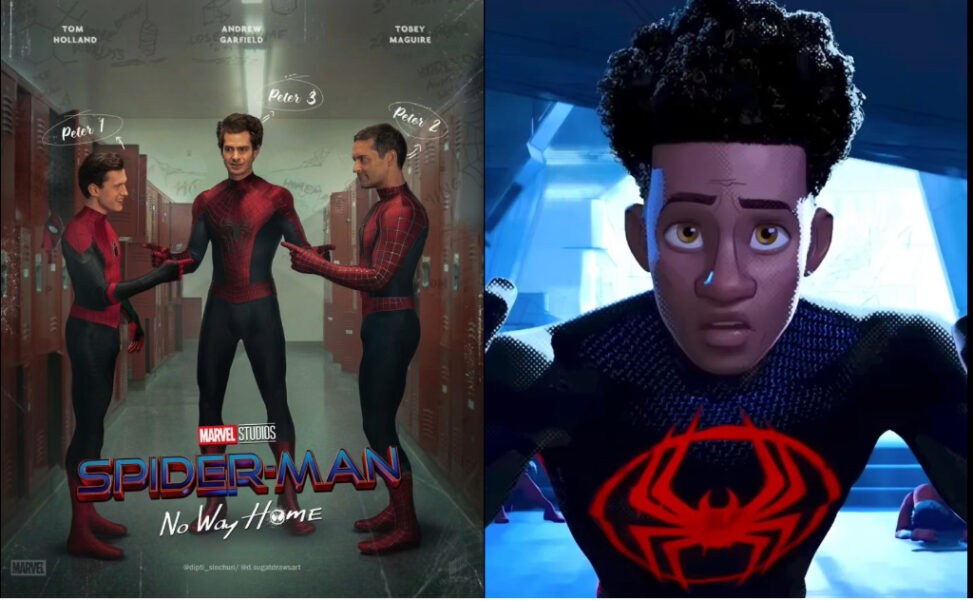Spider-Man is one of the most iconic superheroes in comic book history, first introduced in 1962 as Peter Parker. The character was originally created by Stan Lee and Steve Ditko. Peter embodies themes of responsibility, resilience, and the struggles of adolescence. The character signifies the challenges of growing up, navigating personal dilemmas, and the burden of heroism. Miles Morales was introduced in 2011 in the comic series Ultimate Fallout. The purpose of introducing Miles was to diversify the Spider-Man legacy. With the introduction of Miles Morales in 2011, Spider-Man evolved to signify a broader representation of diverse identities, reflecting contemporary societal issues, particularly regarding race and multiculturalism.
Peter Parker(primarily white and heterosexual) and Miles Morales, a biracial (African-American and Puerto Rican). The character was introduced to reflect the struggles of youth in a post-war America. The character signifies the notion of resilience in the face of adversity, often grappling with personal and social responsibilities. Miles Morales, a biracial character, represents the complexities of identity in a multicultural society. His introduction signifies a broader acceptance and celebration of diversity in superhero narratives, reflecting a more inclusive vision of heroism.
The attributes of Peter Parker include intelligence, relatability, and a strong moral compass. He often struggles with balancing his personal life with his superhero duties, making him an archetype of the “everyman” hero. Peter is portrayed as socially awkward yet ultimately heroic. The character has superhuman powers but often portrayed with relatable flaws; emphasizing the balance of power and responsibility. The character represents the white race, which aligns with the dominant cultural narratives of the 1960’s . However, the attributes of Miles Morales challenges traditional masculinity and exhibits cultural diversity, emotional depth, and a fresh perspective on heroism. He embodies modern youth experiences, particularly in navigating his biracial identity. In addition to spider-like powers, Miles has unique abilities (e.g., camouflage and venom blasts) that symbolizes adaptability and innovation. His biracial identity adds layers of complexity, confronting issues of race and representation directly.
Initially, Peter’s character conformed to the stereotype of a white, middle class male superhero. However, his complexity-facing loss, guilt, and the struggle of adolescence- moves him away from one-dimensional portrayal often seen in early comic book heroes. This nuance has allowed audiences to connect with him on multiple levels. His character development shifted over time to reflect more naunced human experiences and social issues, such as consequences of his actions on his community.
On the other hand, Miles’s character directly challenges stereotypes associated with Black and Latino identities. Rather than being defined solely by his race, he navigates personal and cultural complexities, showcasing a fuller, more authentic experience. This evolution reflects a conscious effort to move away from traditional representations that often reduce characters of color to stereotypes. His storyline often addresses systemic issues, including racial profiling and cultural identity. He becomes a role model, showcasing intelligence, resilience and creativity—traits that challenge the limiting narratives often seen in media.
The evolution of Spider-Man fosters expectations of diversity and inclusivity in media. For audiences, particularly young people from amorginalized backgrounds, seeing a hero like Miles can promote the idea that they too can be heroes. Miles as a character reflects the complexities of real-life identities, encouraging acceptance and understanding across different cultures. This shift can empower marginalized groups, providing relatable role models and encouraging a sense of belonging. The representation of characters like Miles Morales can enhance self-esteem among young viewers of diverse backgrounds, providing them with relatable figures who reflect their experiences. The transition from Peter Parker to Miles Morales signifies broader societal changes towards inclusivity. However, it has also faced backlash from segments of the audience resistent to change, often invoking nostalgia for traditional characters. This reflects deeper societal tensions regarding race and representation. Also, societal changes have included a push for greater diversity in media, reflecting broader movements for racial equality and representation. The success of Spider-Man: Into the Spider-Verse exemplifies a cultural shift towards embracing diverse narratives. However, there can also be backlash, as seen in criticism of cultural appropriation or fears that diversity undermines traditional characters.
Conversely, the media representation remains tokenistic and fails to fully develop characters like Miles, this helps reinforce stereotypes and lead to feelings of invisibility among marginalized groups. This inconsistency contributes to internalized biases and a lack of confidence in one’s identity. Spider-Man, through the lens of both Peter Parker and Miles Morales, exemplifies the evolution of superhero narratives from marginalization to central representation. This transition reflects significant cultural changes, fostering inclusivity while highlighting the complexities of identity in contemporary society. The introduction of Miles Morales has challenged stereotypes and fostered a more inclusive narrative, encouraging diverse identities to embrace their potential for heroism.
Bibliography
Fu, Albert S. 2015. “Fear of a black Spider-Man: racebending and the colour-line in superhero” (re)casting. Journal of Graphic Novels & Comics 6, Nr. 3 (13. January): 269–283. doi:10.1080/21504857.2014.994647, https://doi.org/10.1080/21504857.2014.994647.
Anon. “Black Skins” and White Masks: Comic Books and the Secret of Race on JSTOR. www.jstor.org. https://www.jstor.org/stable/2903369?seq=2.
Molina-Guzmán, Isabel. 2021. 11. Into the Spider-Verse and the Commodified (Re)imagining of Afro-Rican Visibility. In: Rutgers University Press eBooks, 220–242. 16. April. doi:10.36019/9781978814639-012, https://doi.org/10.36019/9781978814639-012.
Koh, Wilson. 2009. Everything old is good again: Myth and nostalgia in Spider-Man. Continuum 23, Nr. 5 (1. October): 735–747. doi:10.1080/10304310903154651, https://doi.org/10.1080/10304310903154651.
Murphy, Bren Ortega, and Jeffery Scott Harder. “1960s Counterculture and the Legacy of American Myth: A Study of Three Films.” Canadian Review of American Studies 23, no. 2 (September 1, 1992): 57–78. https://doi.org/10.3138/cras-023-02-02.
Worrell, Frank C., and Donna L. Gardner-Kitt. “The Relationship Between Racial and Ethnic Identity in Black Adolescents: The Cross Racial Identity Scale and the Multigroup Ethnic Identity Measure.” Identity 6, no. 4 (October 1, 2006): 293–315. https://doi.org/10.1207/s1532706xid0604_1.
Dolby, Nadine. “Youth, Culture, and Identity: Ethnographic Explorations.” Educational Researcher 31, no. 8 (November 1, 2002): 37–42. https://doi.org/10.3102/0013189×031008037.


Nicole chudi-Onyereri
The student offers a thoughtful comparison of Peter Parker and Miles Morales, effectively highlighting both their similarities and differences within the context of evolving societal values. She details how both characters deal with personal responsibilities and the challenges of adolescence, yet emphasizes how they represent different cultural narratives. Peter Parker symbolizes the traditional “everyman” hero archetype, navigating issues typical of a 1960s white male, while Miles Morales embodies contemporary multiculturalism, challenging stereotypes associated with Black and Latino identities.
Her main points include the importance of representation in superhero narratives, the evolution of Spider-Man from a singular identity to a more inclusive representation, and the socio-cultural implications of these changes. She effectively uses scholarly sources to support her analysis, referencing works that discuss race in comics and the impact of representation on youth. This scholarly grounding enhances her argument and demonstrates a critical engagement with the topic.
However, she could deepen her exploration by examining how both characters’ narratives intersect with broader societal issues, such as systemic racism or gender representation. While she notes the backlash against diversity, a more nuanced look at specific instances or critiques could provide richer context.
Including two images would also enhance her discussion by visually contrasting the characters and their representations, reinforcing themes of identity and cultural reimagining. Overall, her analysis presents a compelling argument about the evolution of Spider-Man, though there is room for further depth in exploring the implications of these changes.